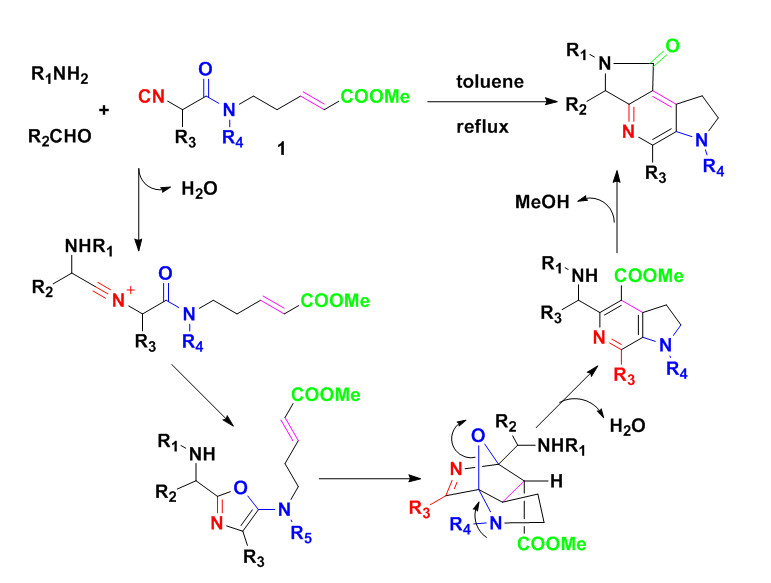Multicomponent reaction (MCR) is a process in which three or more reactants are combined in a single chemical operation to produce a compound that incorporates substantial portions of all starting materials. Mixing three or more substrates bearing each a reactive functional group could provoke different reaction manifolds leading to different final products. In addition, the very domino nature of a MCR implies that any bimolecular reaction would generate a new intermediate function that will in turn enters into the reaction process. Therefore in devising any novel MCR, one has to carefully consider not only the reactivity match of the functional groups, but also that of the incipient intermediate functionalities.
We have been working on the rational “substrate design approach” for the development of MCRs and its interplay with the serendipities. A representative example is shown in the following scheme. The designed substrate 1 contains four functionalities: an isocyano group, an amide, a double bond and an ester. Initiated by nucleophilic addition of isocyano carbon to an in-situ generated iminium, all these reactive functionalities participated in the reaction sequence in a highly ordered manner to afford the observed product. No external reagent was required and heating was the only external energy needed to promote this MCR leading to the creation of five chemical bonds with the concurrent formation of tricyclic ring system. Water and methanol were the only by-products produced in this MCR.

Selected publications:
- Bao, X.; Yokoe, T.; Ha, T. M.; Wang, Q.; Zhu, J. “Copper-Catalyzed Methylative Difunctionalization of Alkenes”Nature Communication, 2018, 9, 3725.
- Clemenceau, A.; Wang, Q.; Zhu, J. “Cooperative Pd/Cu Catalysis: Multicomponent Synthesis of Tetrasubstituted Imidazolones from Methyl a-Isocyanoacetates, Primary Amines and Aryl(vinyl) Iodides” Org. Lett. 2018, 20, 126-129.
- Bunescu, A.; Ha, T. M.; Wang, Q.; Zhu, J. “Copper-Catalyzed Three-Component Carboazidation of Alkenes with Acetonitrile and Sodium Azide” Angew. Chem. Int. Ed. 2017, 56, 10555-10558.
- Qiu, G.; Wang, Q.; Zhu, J. “Palladium-catalyzed Three-component Reaction of Propargyl Carbonates, Isocyanides and Alcohols or Water: Switchable Synthesis of Pyrroles and Its Bicyclic Analogues” Org. Lett. 2017, 19, 270-273.
- Tong, S.; Zhao, S.; He, Q.; Wang, M.-X.; Zhu, J. “Development of New ESIPT Fluorophores Enabled by Y(OTf)3-Catalyzed Reaction of Isocyanides with Thiocarboxylic Acids” Angew. Chem. Int. Ed. 2017, 56, 6599-6603.
- Tong S.; Piemontesi, C.; Wang, Q.; Wang, M.-X.; Zhu, J. “Silver-Catalyzed Three-Component 1,1-Aminoacylation of Homopropargylamines: a-Addition of Both Terminal Alkynes and Isocyanides”Angew. Chem. Int. Ed. 2017, 56, 7958-7962.
- Ha, T. M.; Chatalova-Sazepin, C.; Wang, Q.; Zhu, J. “Copper-Catalyzed Formal [2+2+1] Heteroannulation of Alkenes, Alkylnitriles and Water to g-Butyrolactones: Development and Application to a Total Synthesis of (±)-Sacidumlignan D” Angew. Chem. Int. Ed. 2016, 55, 9249-9252.
- Kong, W.; Wang, Q.; Zhu, J. “Switchable Synthesis of Diversely Functionalized Oxindoles Enabled by Migratory Insertion of Isocyanide to a Transient s-Alkylpalladium(II) Complex” Angew. Chem. Int. Ed. 2016, 55, 9714-9718.
- Chatalova-Sazepin, C.; Wang, Q.; Sammis, G. M.; Zhu, J. “Copper-Catalyzed Intermolecular Carboetherification of Unactivated Alkenes by Alkyl Nitriles and Alcohols” Angew. Chem. Int. Ed. 2015, 54, 5443-5446.
- Buyck, T.; Wang, Q.; Zhu, J. “Roles of Phenylselenonyl Group Enabled a One-pot Synthesis of 1,3-Oxazinan-2-ones From a-Isocyanoacetates, Phenyl Vinyl Selenone and Water” J. Am. Chem. Soc. 2014, 136, 11524-11528.
Book: “Multicomponent Reactions” Zhu, J., Bienaymé, H., Ed. Wiley-VCH, Weinheim, 2005.